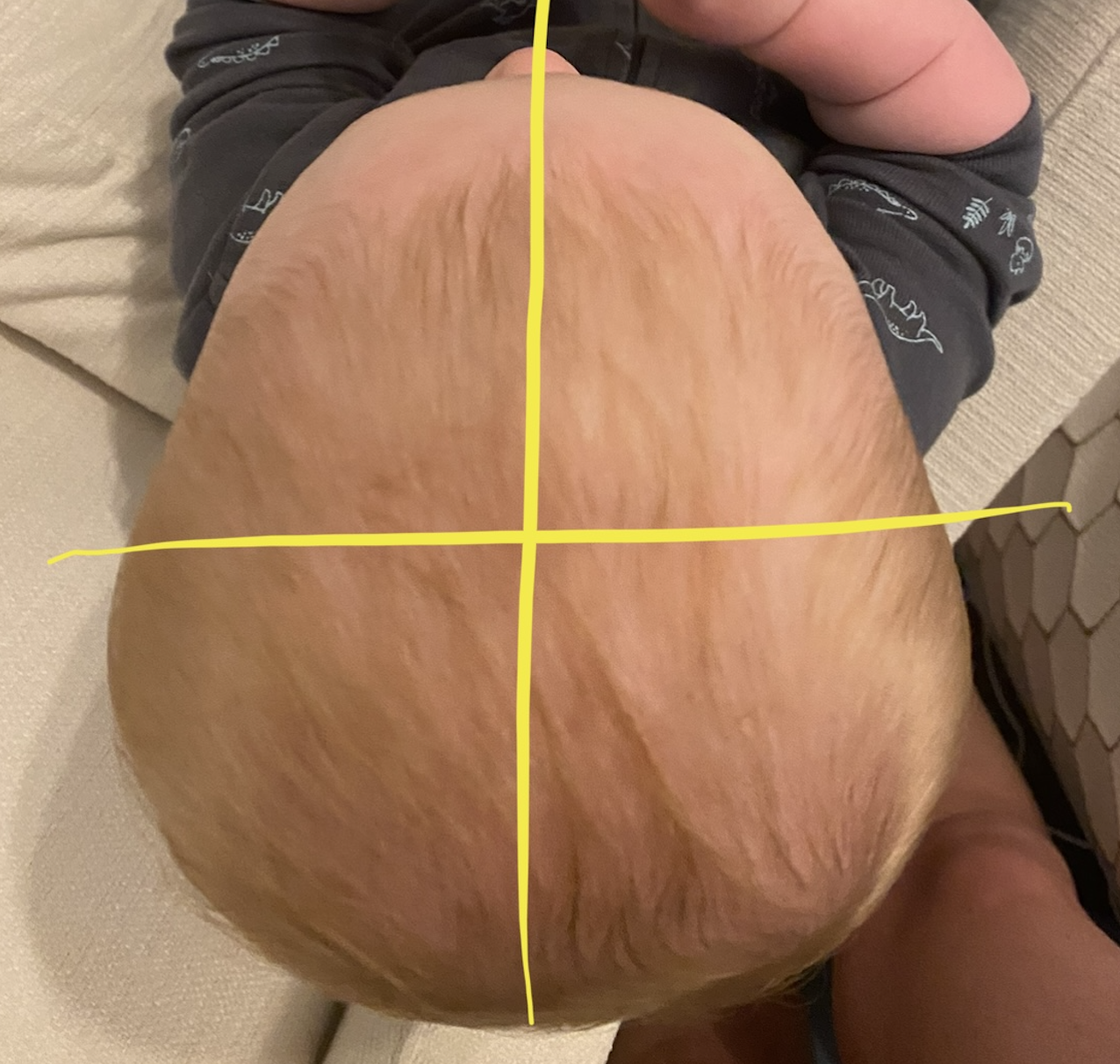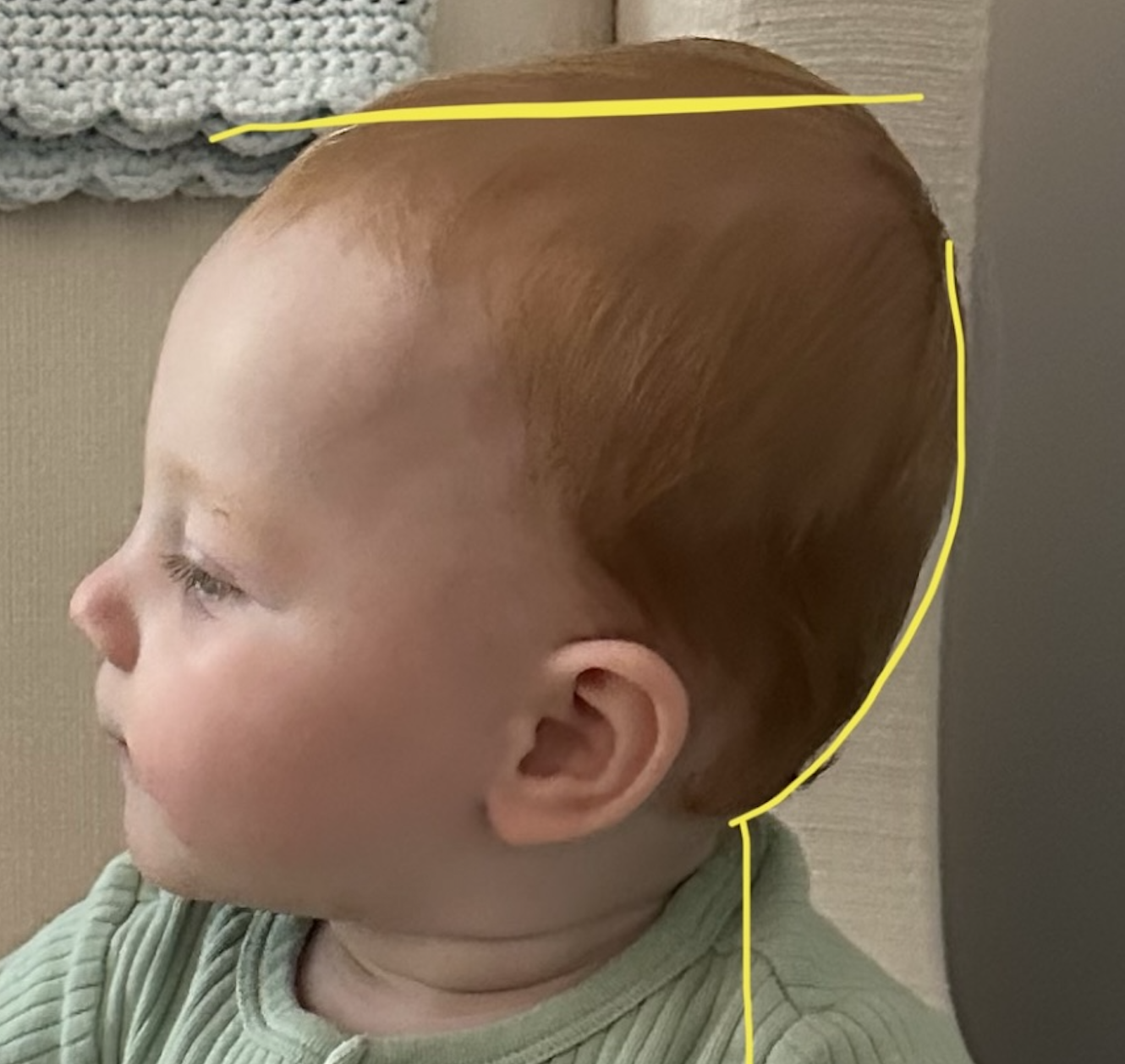Tips to Prevent Flattening of the Head in Infants
Head flattening in babies is a very common occurrence these days, affecting almost 50% if babies. With this increase in occurrence, comes with increased awareness among parents in order to avoid baby helmets (which are so cute, but maybe not ideal). All of this "flat head" talk now has many parents wondering how they can prevent their baby from having head flattening in order to avoid the need for a cranial helmet. Back to sleep is definitely best, but this safe sleeping position leads to prolonged pressure on our baby’s head. Although pressure on the baby's soft skull is inevitable, but there are also many things you can do during the day to limit your baby’s time spent on the back of head and prevent flattening from occurring. As a mom with an infant that had flattening, I want every parent to understand how to prevent this in their baby. So let’s talk about Tips to Prevent Flattening of the Head in Infants.
First, we need to define types of head shape changes in infants. There are a few, and plagiocephaly and brachycephaly are the two most common. Plagiocephaly is the flattening of the side of your baby's head and this is often due to your baby having a head turn preference. Does your baby sleep with their head the same way every night? Do they also keep their head this same direction in the car seat, swing, or during back play? This may mean they are at risk for plagiocephaly. Check the shape, or submit this free form!
Brachycephaly, another common type of flattening of the head in infants, is flattening on the back of the head. This is usually due to your baby keeping their head straight, or mostly straight during back sleep and back play activities. This constant pressure on the back of the head can lead to this type of head shape change.
Lastly, the least common type of flattening of the head in infants is scaphocephaly. This is the result of flattening on BOTH sides of the head which results in a long, narrow head shape. This is usually due to your infant lying on either side of the head and avoiding keeping their head in the middle during most, or all, back sleep and back play activities. It’s so important to understand the different types of head shape changes, so you can PREVENT any flattening from occurring.
Okay, so let’s get into the tips to prevent flattening of the head in your infant.
Tip #1: Prioritize sidelying
When thinking about how to prevent the side and back of your baby’s head from becoming flat, we must consider the equal distribution of pressure. We know our baby is going to spend pretty large amounts of time on their back, especially at night, so we really need to prioritize sidelying positions with our baby. It’s so important to ensure our babies have a variety of positioning since they will already be spending large amounts of time on their back. Sidelying positioning can be prioritized when your baby is on the floor during their wake windows and you can use a boppy, towel, or prop to keep your baby in this position. You can also prioritize this position when using a bassinet stroller by having your baby lay on their sides while in the stroller. You can also prioritize this position during feeding, whether that be by bottle or breast. Sidelying is very important in preventing flattening of the back or side of the head. This sidelying position also encourages rolling skills. If your baby exhibits flattening on both sides of the head, sidelying is a great position to encourage rolling, but midline should also be a main focus for scaphocephaly.
SIDELYING IS NOT A PROPER WAY TO CORRECT FLATTENING. But, this Infant Insights course will help you correct your baby's flattening and avoid a helmet!
Tip #2: Change up tummy time
Tummy time is VERY important in making sure to prevent flattening of the head in infants. Tummy time can present it’s own challenges in our infants because they are not familiar with this position. This position also requires a lot of strength. Be sure to change up tummy time for your baby by changing the toys, support, environment, and interaction. Change up the toys your baby interacts with in tummy time to keep their engagement and encourage prolonged tolerance to the position.
You can use high contrast cards and toys initially, then you can use light up toys when your baby becomes restless in this prone position. You can also support your baby in multiple ways during tummy time, like placing a boppy or rolled towel under their chest to elevate their head and increase enjoyment. You can provide more or less support by placing more or less of your baby’s chest on the pillow. Be sure to alternate this modification with tummy time directly on the floor to encourage increased head control and neck strength.
Thirdly, you can change up the environment to build tolerance to tummy time for your baby. This may look like completing tummy time in the bassinet while strolling outside, in a baby carrier, or outside on a nice day. This will encourage your baby to tolerate prolonged periods of tummy time which will help prevent flattening of the head in your infant. Lastly, create variation in tummy time by changing up the amount of caregiver interaction. Get down at your baby’s level during tummy time to encourage increased tolerance and also social development. This will give your baby motivation, because they LOVE those who love and care for them!
Tip #3: Limit car seat and container time
Another tip in preventing flattening of the head in your infant is limiting the time your baby spends in the car seat or in containers that place pressure on the head. I know pressure on the head at times is inevitable, but it’s so important to be conscious of how much time your baby is spending in these devices. When placing your baby in the car seat, I recommend placing your baby in a baby carrier or bassinet stroller once you have reached your destination. Once your baby is old enough to sit in a highchair, around 6 months plus, it’s important to take your baby out of their car seat when you are at a restaurant to avoid prolonged pressure on their head.
Additionally, you want to be sure if your baby does fall asleep in the car, that you transfer them to their crib or a baby wrap to prevent constant pressure on the head. This confined space and constant pressure can lead to flattening of the head in your infant. As far as containers go, it’s important to limit usage of these items to no more than 30 minutes per day. You also want to double the amount of time your baby spends on the floor in comparison to the time they spend in a bouncer, swing, Mamaroo, or other semi-recliner baby device. These tips will help eliminate prolonged time your baby spends on their back which will prevent flattening of the sides or back to their head. Once your baby is 4 months +, they can use an upright seat, like an UPSEAT, and it's important to move away from the baby bouncer or swing at this age.
Tip #4: Monitor your baby’s head shape
Monitoring your baby’s head shape is HUGE. This will help you keep an eye on any changes (good or bad) and ensure that your baby’s head does not become significantly flat. Monitoring your baby’s head shape is one of the most important parts in preventing flattening of your infant’s head. When monitoring your baby’s head shape, you want to take photos from the top (bird’s eye view) and sides at 4-6 weeks of age.
Then, you want to be sure to take photos at those same angles every 2 weeks to monitor any changes. When taking photos from a top view, you want to divide the head down the middle and note any differences in the sides. When taking the photo from the side view, or profile view, you want to be sure that the back is beginning to curve and the head does not rise a large amount from the forehead to back of head. In the event that you see that your baby’s head has become flat, if you are monitoring closely from a young age, you will have time to address the flattening conservatively prior to seeking helmet therapy. Monitoring your baby’s head shape will help keep you aware that flattening can occur and proactive in correcting the shape if mild flattening does present. Submit a free form here if you want me to assess your baby’s head shape for free!

Tip view to monitor flattening of the sides of the head

Side view to monitor flattening of the back of the head
Tip #5: Stretch your baby
Lastly, stretching our baby’s neck and body is very important in preventing flattening of the head in your infant. Flattening is often due to stiffness in our baby’s neck, which causes the baby to maintain their head in one single, and desired position. As stated above, this constant pressure from the preferred positioning can lead to flattening. Stretching your baby’s neck, reduces their stiffness and encourages your baby to move their head well in all ways. When stretching your baby’s neck, you should be sure to stretch gently and monitor signs of discomfort. You also want to be sure to protect the integrity of the joints and muscles, so do not stretch your baby to a point of discomfort. When stretching your baby’s neck, it’s important to stretch in all planes to ensure that all of the muscles are flexible. Download our FREE "Flat Head" Guide for visuals and more information on stretching your baby’s neck. In addition to stretching your baby’s neck, you should also stretch their whole body to ensure there is no tightness or stiffness in other joints. When the neck is tight, the shoulders, hips, and trunk can also become tight.
I WISH I would have known this information before I had my son James! But, I learned from my experiences and implemented all of the tips above with my second born to avoid "flat head". I hope you will too so you can significantly lower your baby’s risk of developing “flat head”.










